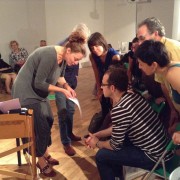Extraits de la performance au POP-Montreal CBC
Lire l’article concernant ce spectacle sur le site de CBC Music.
Le chant des ondes: le film
Le superbe film le chant des ondes de Caroline Martel présente la naissance et l’évolution des ondes musicales à travers le siècle dernier jusqu’à nos jours. Ce film documentaire dresse un regard sur la place qu’a occupé et occupe encore cet instrument dans le lien entre la musique, les arts, la science, les technologies et la sensibilité humaine. Nous y retrouvons en cours de visionnement, Geneviève Grenier ainsi que les membres de l’Ensemble d’ondes de Montréal, dans l’atelier de leur technicien Jean Landry, discuter autour de leurs instruments.
Le chant des ondes par ONFB, Office national du film du Canada
Demandez une présentation personnalisée et accompagnée d’une démonstration des ondes Martenot avec Gen’viève Grenier par téléphone via notre formulaire de contact.
http://artifactproductions.ca/lechantdesondes/
TURANGALÎLA-TRISTAN, Quite a play of classical contrasts…
Sunday brought the Philharmonia Orchestra of Yale to Carnegie Hall for a reading of Messiaen’s Turangalîla Symphonie, with Reinbert de Leeuw conducting. A gifted older maestro, young and hungry players — the mix couldn’t have been more combustible. The sprawling 10-movement work of the mid-’40s involves spine-tingling sustained crescendos and hints of Romanticism, and uses a strange electronic keyboard called the ondes Martenot, played beautifully by Geneviève Grenier. I took a close look right before the concert and it looked like the kind of ancient-to-the-future device that could easily turn up on a Brooklyn jazz bandstand. But most of all, hats off to featured pianist Wei-Yi Yang, who nearly did windmills while pounding out Messiaen’s unfathomable chords, landing with fine dynamic control and perfect enunciation.
David R. Adler
A Monumental Messiaen Speaks Many Languages
The performance was sensational: well prepared, solidly and precisely executed, and rippling with high-energy percussion and brass playing and a fluid interplay of polished strings as well as winds. If you were looking for a demonstration of how completely a conductor can convey an unusual work’s ideas in all their complexity and beauty, and inspire his musicians to play the piece as if it is the most vivid, original music ever written, you could hardly have done better than this…
But in a way the work’s inspiration, musical sources and relationship with Messiaen’s other music need not matter. Taken entirely on its own, this is a masterpiece of color, texture and peculiarly alluring turns of phrase. Mr. de Leeuw made every moment of it taut and exciting, and Wei-Yi Yang, playing the sparkling piano line, contributed significantly and virtuosically, as did Geneviève Grenier, who produced the score’s otherworldly electronic lines on the ondes martenot.
By ALLAN KOZINN
Lire la critique complète sur le site de The New York Times
Yale Philharmonia in Messiaen’s Ecstatic Turangalîla
Sunday night’s performance at Carnegie Hall by the Philharmonia Orchestra of Yale under Reinbert De Leeuw was part of the Messiaen Centenary Celebration at Yale (his birthday was December 10th) and is part of a five-event “Yale in New York” series. De Leeuw was a close friend of the composer’s and is a known expert on his music; the performance was assured and luminous. It might be easy to just go for the grand effects, but the so-called “Love song” movements were played with a type of lyricism that stressed the melodic content, with long lines played handsomely by the Yale strings. The sexy swooping of the ondes Martenot was never reduced to a gimmick; the integration of this strange instrument, gorgeously played by Geneviève Grenier, into the orchestral fabric was masterful throughout. Wei-Yi Yang, the pianist, whether hanging out at the top of the keyboard making the most astonishing tinkling sounds or attacking the big cadenzas at the close of the first or fourth movements, was untiring, passionate and poetic. He practically danced during the jazzy sections; it was a joy to behold.
No one held back in the crazed fifth and tenth movements, a veritable orgy of sound. The fifth, “Joy of the Blood of the Stars,” has underpinnings of jazz, broadway, and simple, boisterous fun, with brass blaring brilliantly, and the finale, jumpy rhythms and all, was completed with a long-held chord that left the audience dazed.
Robert Levine
L’article original sur le site Classics Today n’est plus disponible.
Extrait de l’émission «Rendez-Vous en Musique»
Entrevue avec Marie-Andrée Ostiguy dans le cadre de l’émission “Rendez-Vous en Musique” et du 100ème anniversaire de Messiaen.
Critique de Donna Doherty, Register Arts Editor
…The Dutch conductor Reinbert de Leeuw, who helped create the program, is one of the world’s foremost Messiaen interpreters and a close friend of the late composer. He will lead the Philharmonia Orchestra of Yale Friday in the highlight concert, the monumental 10-movement “Turangalila-Symphonie.” Purvis describes the work, featuring pianist Wei-Yi Yang and Genevieve Grenier on the ondes Martenot (an early electronic keyboard instrument), as having “unbelievable sound color.”…
Donna Doherty, Register Arts Editor







